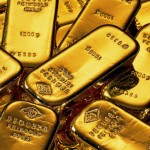Gold swung between gains and losses on Wednesday, with the US dollar remaining mostly steady, as investors eyed the highly-anticipated Fed minutes. Copper rose amid heightened risk appetite and as US building permits surged to the highest in six years.
On the Comex division of the New York Mercantile Exchange, gold futures for settlement in December stood 0.13% lower at $1 195.6 per troy ounce at 12:58 GMT, having shifted in a daily range of $1 201.7-$1 191.0. The precious metal rose 1.15% on Tuesday to $1 197.1 after it touched a 2-1/2-week intraday high of $1 204.1.
Gold traded not far off yesterday’s high after a series of short-coverings, but with bearish factors still in control of the market, the precious metal failed to turn its psychological resistance of $1 200 into a support.
The US dollar traded higher during most of the day against a basket of major trading partners on Wednesday. The greenback reached a fresh seven-year high against the yen after the Japanese economy shockingly slid into recession and Bank of Japan introduced no changes to monetary policy on Wednesday.
Support was drawn by physical demand from central banks. Russia’s central bank has purchased 150 tons of gold so far in 2014, governor Elvira Nabiullina said on Tuesday, compared to 77 tons in the previous year, according to IMF data.
ECB Executive Board member Yves Mersch said yesterday that the central bank may adopt unconventional measures to counter low inflation, including the purchase of assets such as gold, exchange-traded funds, sovereign debt, and even real estate.
Investors also eyed an upcoming referendum in Switzerland on November 30th when voters will decide whether the country’s central bank should keep at least 20% of its assets in gold, compared to the current 8%.
An opinion poll, due on Wednesday, will show whether support for the central banks measure continues to decline, compared to around 44% in October.
However, despite the improving physical demand stemming from lower prices, the market’s bearish stance is still in play, with the precious metal’s movement remaining predominantly tied to swings in the US dollar.
The US dollar index for settlement in December traded at 87.695 at 12:58 GMT, up 0.06% on the day, having varied in a daily range of 87.850-87.545. The contract shed 0.41% on Tuesday to 87.645, pressured by a stronger euro, but remained in close proximity to Friday’s 4-1/2-year high of 88.365.
With foreign central banks boosting stimulus measures, while the Federal Reserve wrapped up its Quantitative Easing program at its last meeting and prepares for an interest rate hike next year, the dollar is poised for more upside in the long-term, setting a bearish stage for gold.
Reflecting grim investor sentiment toward the precious metal, assets in the SPDR Gold Trust, the biggest bullion-backed ETF, remained unchanged at 723.01 tons on Tuesday. Holdings fell to 720.62 tons on Thursday, the lowest since September 2008.
Copper
Copper rose on Wednesday amid hopes that additional stimulus measures in Europe will spur growth, while US building permits jumped in October to the highest since 2008.
Comex copper for delivery in December rose 1.33% to $3.0420 per pound by 12:58 GMT, having shifted in a daily range of $3.0475-$2.9900. The industrial metal slid 1.23% on Tuesday to $3.0020. Prices jumped to a two-week high of $3.0610 the day before.
The US Department of Commerce reported that residential-construction permits rose to an annualized 1.080 million in October, the highest in six years, following an upward-corrected 1.031 million a month earlier. Month-on-month, building permits increased 4.8%, exceeding analysts projections for a 0.9% jump following Septembers 1.5% increase.
Housing starts, however, slid 2.8% to an annualized 1.009 million rate in October, following the preceding months 1.038 million, which was better than initially estimated.
Ryan Wang, an economist with HSBC Securities USA Inc., said for Bloomberg: “Conditions in the housing market are at least stable, and on the margin they appear to be improving a bit. I think we should expect continued gradual growth heading into next year.”
Hopes of additional stimulus measures in Europe and Japan bolstered risk appetite, also lifting the red metal. The European Commission will implement a 300-billion-euro ($300 billion) package of public and private investment over the next three years to spur growth and improve the labor market. Meanwhile ECB President Mario Draghi has underscored the central banks readiness for additional measures, if current steps fail.
Japan slipping into recession dealt a heavy blow to the metals demand prospects, but Prime Minister Shinzo Abes call on snap elections and a delay in the introduction of an unpopular tax hike fueled speculations for new stimulus measures.
Improving investor confidence in Germany and the Eurozone as a whole, reported on Tuesday, also fanned positive sentiment, but long-standing expectations for a wide supply surplus next year kept a thick shadow over the market. According to a Reuters poll, the market will swing to a 350 000-ton surplus next year, compared to a minor deficit in 2014.





